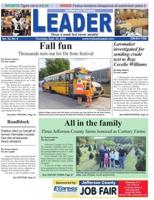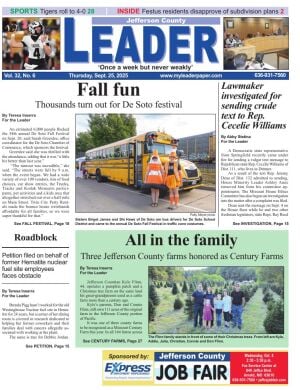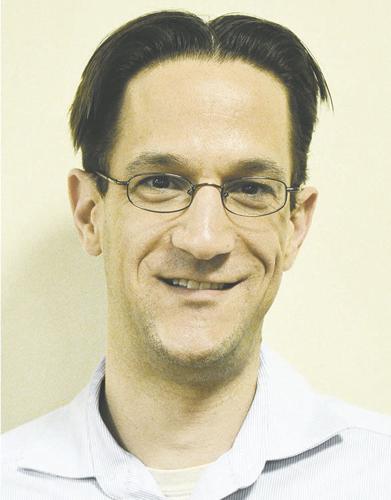Jefferson County officials are looking to assume control of up to 150 miles of subdivision streets that are now under private ownership.
Public Works Director Jason Jonas said his department has begun accepting applications from subdivision homeowner associations that want the county to take over maintenance of their streets.
“We’re already reviewing two of the applications,” Jonas said, “and we’ve got another three or four considering it. And I’ve talked with maybe a half-dozen more.”
Assuming control of subdivision streets is a step forward for Jefferson County, which has never done so before, Jonas said.
Many other counties, on the other hand, do. For example, St. Louis County maintains about 600 miles of subdivision streets, and St. Charles County maintains 285 miles of those kinds of streets, Jonas said.
“We now have 667 miles of county maintained roads, and by my estimate, there are about 15,000 to 20,000 homes that front a county road, so we’re serving about 50,000 people in our unincorporated areas directly,” Jonas said. “If we take in another 125 to 150 miles, we’d double that. We will have a direct effect on the lives and property of 50,000 more people. That alone makes it worth doing.”
Under the program, once a street or series of streets is approved, the county’s Highway Division will assume responsibility for maintaining and repairing those roads.
That’s opposed to the current patchwork system, in which most subdivision streets are maintained – or not maintained – by homeowners associations made up of residents who live in those developments.
Jonas said the program is meant to prevent what’s happened in unincorporated areas with wastewater.
“We have hundreds of failing private sewer and septic systems throughout the county,” he said. “That’s an infrastructure problem that only now is being addressed. If you go to subdivisions that are 30 or 40 years old, you’ll see crumbling streets that the residents don’t have the expertise to repair. We don’t want another part of our infrastructure – our streets and roads – to have the same problem.
“The problem with homeowners associations is over the years, they fall apart – you have trouble getting people to do what is a thankless job – and the yearly assessments typically only take in routine maintenance, things like pothole repairs and some snow removal. A couple of decades into the life of a subdivision, the streets start falling apart, and it might cost $500,000 to $600,000 to fix. If there’s 100 lots in the subdivision, most people would have a lot of trouble coming up with $5,000 or $6,000. And you’re asking people with no expertise (on subdivision boards) to negotiate with contractors. Are they getting the best deal?”
However, Jonas said the county is not looking to assume subdivision streets that are falling apart.
“That would bankrupt us,” he said.
Instead, Jonas said, he’d like to see streets in newer developments brought under county control – typically, those that have been built since 1998.
How the county would pay
Jonas said the county could “easily” assume 125 to 150 miles of extra streets without a tax increase.
He said funding to maintain those streets would come from revenue generated by the county’s road and bridges property tax of .2415 per $100 of assessed valuation, as well as from increasing the county’s share of the state’s motor fuel tax (of 17 cents per gallon).
Part of the motor fuel tax is shared with counties through the County Aid Road Trust (CART) program and is allocated according to the number of miles of roads each county maintains.
“Compared with a lot of other counties, we’re not getting our fair share of CART money,” Jonas said. “The state funding pays at least $1,500 per mile of road. If we can get money from the state to do this, why wouldn’t we take that opportunity?”
The countywide 1/2-cent sales tax for road and bridge improvements would not be used for subdivision streets, Jonas said.
Jonas said the Highway Division would most likely have to add to its roster of 90 full-time employees plus another dozen or so seasonal workers, but not dramatically.
“We’ll likely be adding 20 or 30 miles per year over five years, which we can take on without a lot of issues. We will need more boots on the ground so that we’re making sure we’re serving the roads we already have effectively.”
“And we can do things more efficiently than a homeowners’ board,” he said. “We have a staff of experienced professional engineers. We buy asphalt and salt in bulk. We will know when something needs to be repaired or replaced before it becomes a safety problem. There are certain efficiencies of scale that we can bring to the table.”
Other benefits
While Jonas wouldn’t say that taking over private subdivision streets would bolster property values, he did say it might promote home sales.
“I can only speak to my experience, and I talk with real estate agents all the time – and sometimes prospective buyers – who call me and ask about some street in a subdivision that they’d like to see us address before they put the house on the market or buy. Almost every time, I have to tell them that it’s not our street, and we won’t be repairing it. Does that mean the home isn’t going to sell? I can’t say that, but I do know I take those calls several times a week.”
He also said taking street maintenance out of the equation for homeowners associations may ease their burden.
“Would they lower their assessments? I can’t say that,” he said. “That would be up to the individual boards. But they might, or they might be able to use the money for other purposes in the subdivisions.”
How the program works
Jonas said once a subdivision applies for street takeover, his department will grade the application according to a number of criteria, including the streets’ conditions, how closely pavement matches county standards, traffic counts and access to other county roads.
Jonas conceded that newer streets will likely fare better than older ones.
“But even older ones that are in poor repair, the subdivision would be served by applying, and they can do so at no cost. Even if their streets are not a good fit for our program, we’ll offer our assessment on what work needs to be done to make them better.”
He said any subdivision that has a bridge should apply.
“For federal and state funding, a bridge must be 20 feet long,” he said. “You would be surprised how many of these bridges are at the front of a subdivision that has only one access and exit point. And they’re not being inspected, they’re not being repaired and they’re not being maintained. Even if a subdivision’s streets aren’t accepted, we have a high interest in bridges. Those bridges would be eligible for matching funding (coordinated by the East-West Gateway Council of Governments), but even more importantly, deteriorating bridges are a life, health and safety risk to the community.”
Only paved streets (asphalt or concrete) will be accepted, not gravel roads, Jonas said. Driveways also will not be taken over by the county.
Jonas advises homeowner association trustees who may be interested in applying for the takeover to go to the public works section on the county’s website, jeffcomo.org, and look over a document that outlines the “subdivision street acceptance policy.”
“Once they read that, it will tell how to proceed from there,” he said.





